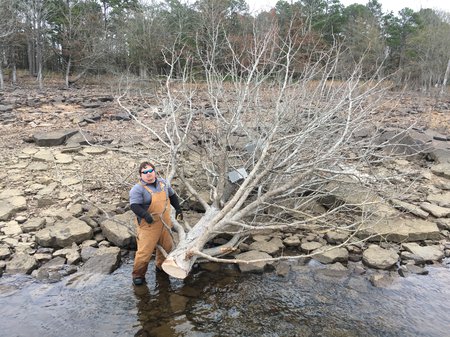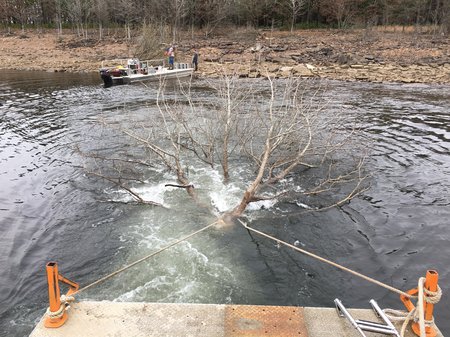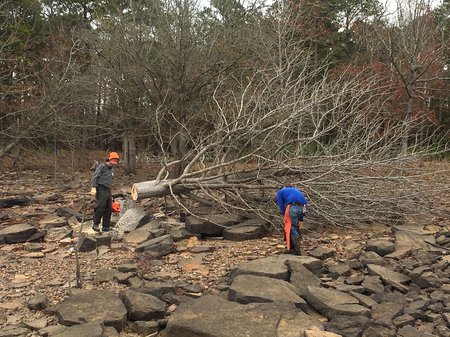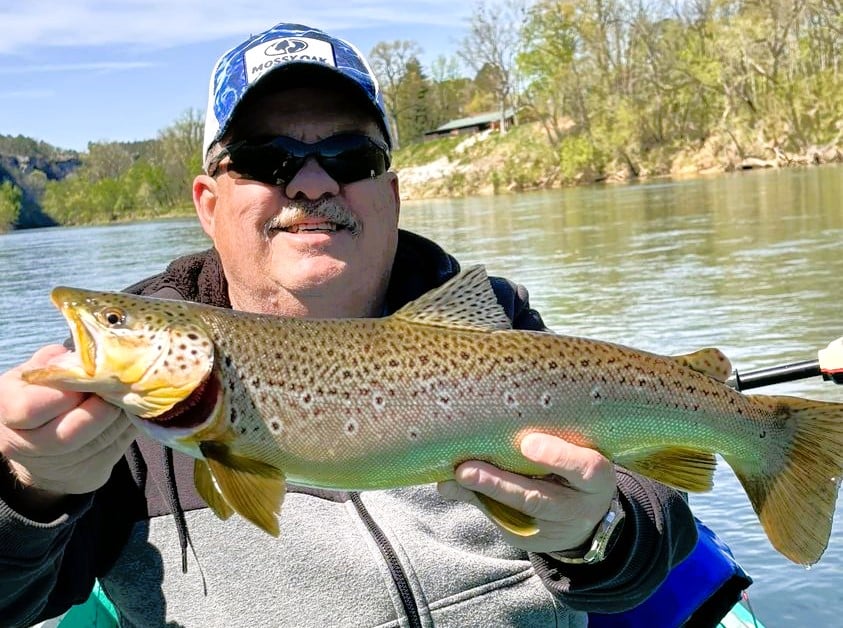Sixty new habitat structures put in place on Greers Ferry Lake
BY Jim Harris
ON 12-16-2020

Dec. 16, 2020
Jim Harris
Managing Editor Arkansas Wildlife Magazine
HEBER SPRINGS – Anglers at Greers Ferry Lake will see an immediate benefit in coming months from a large-scale habitat project conducted Nov. 30-Dec. 4 at Greers Ferry Lake that involved 23 biologists and technicians of the Arkansas Game and Fish Commission’s Fisheries Division.
The AGFC staff, led by Tom Bly, the supervisor of the district that manages Greers Ferry Lake, and with the Army Corps of Engineers’ approval and assistance, were able to harvest and sink 345 trees from a pair of islands and other areas on the lower end of the lake to establish 60 habitat sites.
“I thought the project was very successful, especially given the weather conditions,” Bly said, noting that winds of 10-15 mph on the first day forced the staff to wait a day to venture out on the lake. But once things quieted down on the water, nearly two-dozen staffers divided into three teams and got in three and a half days of habitat work around Goat Island and Scout Island, situated between Cherokee Recreation Area and Heber Springs Recreation Area and in the vicinity of Old Highway 25 Recreation Area.

Coordinates for the new sites will be added to the AGFC Interactive Map and in the Downloadable Fish Attractor Files by early in 2021, Bly said.
The lower end of 32,000-acre Greers Ferry Lake is the portion between The Narrows and the dam. The crews worked out of Heber Springs Marina all week.
“The marina staff was very helpful in providing mooring for our boats and assistance with refueling,” Bly said.
The Corps provided the heavy equipment required to move tons of concrete block onto the AGFC’s barges to help sink the trees. Staff sought heavy-limbed sweet gum with a base of 6-16 inches in diameter at the stump.
The Fisheries Division starting in 2016 began planning two large-scale habitat projects a year on major Arkansas lakes, targeting such lakes as Bull Shoals, Norfork, DeGray, Chicot, SWEPCO and Monticello. Similar projects on the Corps-owned lakes where AGFC staff could harvest nearby trees to float them out for sinking in designated habitat sites have provided “the most bang for the buck,” Bly said.
The latest project on Greers Ferry was the second done there; the first, the guinea pig of the overall large-scale project plan, was on the upper end based out of Choctaw Recreation Area. The planning for this project with the Corps was more than a year in the making, Bly said. The AGFC biologists have mapped out a total of 140 sites for improved habitat on Greers Ferry Lake.
“The goals of these projects are to enhance the complexity of habitat for fish and to enhance the angler’s experience on the water,” Bly said.

All three species of bass, but especially the prevalent smallmouth bass on this portion of the lake, benefit not only from cover in which to hide but also to ambush prey, Bly noted. Crappie, sunfish like bluegill and longear, flathead and channel catfish, and walleye also are attracted to the structure.
“We schedule these projects months in advance and work around our folks’ sampling schedules and, of course, deer season, as some of our people like to schedule vacations for hunting,” Bly said. “It’s not something you can reschedule on a whim because it might rain for a few days. And at this time of year, you don’t know if the weather forecast will hold true or not. Even though we lost a half-day at the start, we completed 60 sites, which was what we were anticipating.”
Though the project work was similar to work at other lakes, each lake presents its own set of challenges, Bly said.
“On Greers Ferry, we were dealing with shoreline that had less slope than on Bull Shoals and Norfork; therefore, it took more effort to get the trees down to the water’s edge.”
Anglers’ comments at meetings where the AGFC’s fishery management plan for Greers Ferry was developed influenced the work, Bly said. Anglers had requested shallower, near shore habitat and more habitat sites on the lower end of the lake. The Corps identified areas around the lake we could harvest trees and it would not impact adjacent landowners and the habitat sites would not be hazardous to recreational boat traffic.
Boats with sonar ran the shoreline looking at the topography, he said. Some areas could be too steep, with 100-foot drop-offs such as near the river channel; other areas might prove too flat for the staff to get in close enough to the tree line to harvest trees and drag them out. Some trees that were in full foliage a few months ago when the area was scouted had lost their leaves and weren’t candidates for harvest.
“Our target depth was 20 feet or less. Quite a few of the sites were in standing dead timber so we were able to enhance what was already there,” he said, adding that all of the sites were in standing dead timber or near shore so they would not pose a navigation hazard to boaters.
Another goal, Bly said, was to help anglers by establishing habitat sites that were in closer proximity to each other than those found at other lakes.

“Most of these sites were a quarter-mile or less apart,” he said. “When you have multiple anglers wanting to fish the only fish habitat site in the area, an ethical angler will give way to the angler who got there first. Our goal was to put enough sites around these islands near each other so you wouldn’t have to go far to find one that was not occupied.”
These large-scale projects within the division incorporate personnel from the state’s hatcheries, Trout Management Program, the Black Bass Program and Research. The habitat biologist or district supervisor over the particular lake being addressed handles the manning of crews and serves as crew leader and coordinator, plus purchases the material needed such as concrete block and wire. With enough staffers on hand for the Greers Ferry Lake project, three crews were assigned to different sites, and each had two boats – one for pulling the trees to the water’s edge and deploying the trees to the habitat site, while another hauled concrete block, other equipment and the rest of the team.
Recent News

Arkansas Wildlife Weekly Fishing Report
Apr. 18, 2024
Subscribe to Our Weekly Newsletter E-mails
Don’t miss another issue. Sign up now to receive the AGFC Wildlife Weekly Newsletter in your mailbox every Wednesday afternoon (Waterfowl Reports are published weekly during waterfowl season and periodically outside the season). Fishing Reports arrive on Thursdays. Fill in the following fields and hit submit. Thanks, and welcome!

